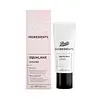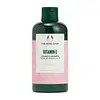What's inside
What's inside
 Key Ingredients
Key Ingredients

 Benefits
Benefits

 Concerns
Concerns

 Ingredients Side-by-side
Ingredients Side-by-side

Water
Skin ConditioningC12-15 Alkyl Benzoate
AntimicrobialGlycerin
HumectantDipropylene Glycol
HumectantIsononyl Isononanoate
EmollientIsohexadecane
EmollientCetearyl Alcohol
EmollientCaprylic/Capric Triglyceride
MaskingPEG-100 Stearate
Glyceryl Stearate
EmollientSqualane
EmollientPEG-6 Caprylic/Capric Glycerides
EmulsifyingDimethicone
EmollientPhenoxyethanol
PreservativeMethylparaben
PreservativeCarbomer
Emulsion StabilisingTocopheryl Acetate
AntioxidantEthylhexylglycerin
Skin ConditioningSodium Hydroxide
BufferingDisodium EDTA
Xanthan Gum
EmulsifyingWater, C12-15 Alkyl Benzoate, Glycerin, Dipropylene Glycol, Isononyl Isononanoate, Isohexadecane, Cetearyl Alcohol, Caprylic/Capric Triglyceride, PEG-100 Stearate, Glyceryl Stearate, Squalane, PEG-6 Caprylic/Capric Glycerides, Dimethicone, Phenoxyethanol, Methylparaben, Carbomer, Tocopheryl Acetate, Ethylhexylglycerin, Sodium Hydroxide, Disodium EDTA, Xanthan Gum
Water
Skin ConditioningEthylhexyl Palmitate
EmollientIsohexadecane
EmollientSorbitol
HumectantDimethicone
EmollientSorbitan Stearate
EmulsifyingGlycine Soja Oil
EmollientTriticum Vulgare Germ Oil
EmollientPhenoxyethanol
PreservativeGlyceryl Stearate
EmollientPEG-100 Stearate
Cetearyl Alcohol
EmollientTocopherol
AntioxidantButyrospermum Parkii Butter
Skin ConditioningAcrylates/C10-30 Alkyl Acrylate Crosspolymer
Emulsion StabilisingParfum
MaskingEthylhexylglycerin
Skin ConditioningRubus Idaeus Seed Oil
EmollientSodium Hydroxide
BufferingDisodium EDTA
Benzyl Benzoate
AntimicrobialBenzyl Alcohol
PerfumingGeraniol
PerfumingLinalool
PerfumingLimonene
PerfumingHydroxycitronellal
PerfumingAlpha-Isomethyl Ionone
PerfumingCitric Acid
BufferingWater, Ethylhexyl Palmitate, Isohexadecane, Sorbitol, Dimethicone, Sorbitan Stearate, Glycine Soja Oil, Triticum Vulgare Germ Oil, Phenoxyethanol, Glyceryl Stearate, PEG-100 Stearate, Cetearyl Alcohol, Tocopherol, Butyrospermum Parkii Butter, Acrylates/C10-30 Alkyl Acrylate Crosspolymer, Parfum, Ethylhexylglycerin, Rubus Idaeus Seed Oil, Sodium Hydroxide, Disodium EDTA, Benzyl Benzoate, Benzyl Alcohol, Geraniol, Linalool, Limonene, Hydroxycitronellal, Alpha-Isomethyl Ionone, Citric Acid
Ingredients Explained
These ingredients are found in both products.
Ingredients higher up in an ingredient list are typically present in a larger amount.
Cetearyl alcohol is a mixture of two fatty alcohols: cetyl alcohol and stearyl alcohol. It is mainly used as an emulsifier. Emulsifiers help prevent the separation of oils and products. Due to its composition, it can also be used to thicken a product or help create foam.
Cetearyl alcohol is an emollient. Emollients help soothe and hydrate the skin by trapping moisture.
Studies show Cetearyl alcohol is non-toxic and non-irritating. The FDA allows products labeled "alcohol-free" to have fatty alcohols.
This ingredient is usually derived from plant oils such as palm, vegetable, or coconut oils. There is debate on whether this ingredient will cause acne.
Due to the fatty acid base, this ingredient may not be Malassezia folliculitis safe.
Learn more about Cetearyl AlcoholDimethicone is a type of synthetic silicone created from natural materials such as quartz.
What it does:
Dimethicone comes in different viscosities:
Depending on the viscosity, dimethicone has different properties.
Ingredients lists don't always show which type is used, so we recommend reaching out to the brand if you have questions about the viscosity.
This ingredient is unlikely to cause irritation because it does not get absorbed into skin. However, people with silicone allergies should be careful about using this ingredient.
Note: Dimethicone may contribute to pilling. This is because it is not oil or water soluble, so pilling may occur when layered with products. When mixed with heavy oils in a formula, the outcome is also quite greasy.
Learn more about DimethiconeDisodium EDTA plays a role in making products more stable by aiding other preservatives.
It is a chelating agent, meaning it neutralizes metal ions that may be found in a product.
Disodium EDTA is a salt of edetic acid and is found to be safe in cosmetic ingredients.
Learn more about Disodium EDTAEthylhexylglycerin (we can't pronounce this either) is commonly used as a preservative and skin softener. It is derived from glyceryl.
You might see Ethylhexylglycerin often paired with other preservatives such as phenoxyethanol. Ethylhexylglycerin has been found to increase the effectiveness of these other preservatives.
Glyceryl Stearate is a mix of glycerin and stearic acid.
It is used to stabilize the mixing of water and oil ingredients. By preventing these ingredients from separating, it can help elongate shelf life. It can also help thicken the product's texture.
As an emollient, it helps soften skin and supports barrier-replenishing ingredients.
In cosmetics, Glyceryl Stearate is often made from vegetable oils or synthetically produced.
This ingredient may not be fungal-acne safe
Fun fact: The human body also creates Glyceryl Stearate naturally.
Learn more about Glyceryl StearateIsohexadecane is added to enhance texture, emulsify, and to help cleanse. It is an isoparrafin. It is a component of petrolatum.
Due to its large size, Isohexadecane is not absorbed by the skin. Instead, it sits on top and acts as an emollient. Emollients help keep your skin soft and smooth by trapping moisture within.
Isohexadecane is often used in products designed to help oily skin. It is lightweight and non-greasy while helping to moisturize. When mixed with silicones, it gives a product a silky feel.
Learn more about IsohexadecanePeg-100 Stearate is an emollient and emulsifier. As an emollient, it helps keep skin soft by trapping moisture in. On the other hand, emulsifiers help prevent oil and water from separating in a product.
PEGS are a hydrophilic polyether compound . There are 100 ethylene oxide monomers in Peg-100 Stearate. Peg-100 Stearate is polyethylene glycol ester of stearic acid.
Phenoxyethanol is a preservative that has germicide, antimicrobial, and aromatic properties. Studies show that phenoxyethanol can prevent microbial growth. By itself, it has a scent that is similar to that of a rose.
It's often used in formulations along with Caprylyl Glycol to preserve the shelf life of products.
Sodium Hydroxide is also known as lye or caustic soda. It is used to adjust the pH of products; many ingredients require a specific pH to be effective.
In small amounts, sodium hydroxide is considered safe to use. However, large amounts may cause chemical burns due to its high alkaline.
Your skin has a natural pH and acid mantle. This acid mantle helps prevent harmful bacteria from breaking through. The acid mantle also helps keep your skin hydrated.
"Alkaline" refers to a high pH level. A low pH level would be considered acidic.
Learn more about Sodium HydroxideWater. It's the most common cosmetic ingredient of all. You'll usually see it at the top of ingredient lists, meaning that it makes up the largest part of the product.
So why is it so popular? Water most often acts as a solvent - this means that it helps dissolve other ingredients into the formulation.
You'll also recognize water as that liquid we all need to stay alive. If you see this, drink a glass of water. Stay hydrated!
Learn more about Water